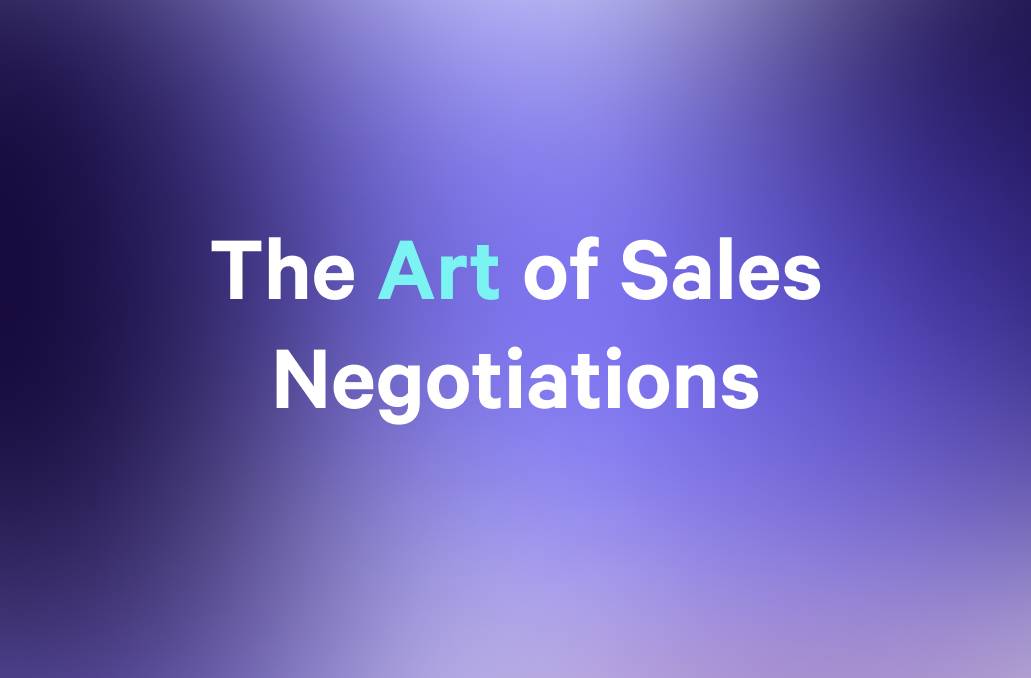Effective sales conversations are an integral component of the sales process, from lead generation to closing deals. However, for many sales professionals and entrepreneurs, initiating and leading a successful sales conversation can be challenging.
Are you struggling to engage potential buyers and persuade them to make a purchase? If so, you're not alone. Many sales reps and sales teams struggle. This piece aims to equip you with practical guidance to enhance your skills in conducting successful sales conversations.
From defining a sales conversation to sharing key strategies and techniques, we've curated content to improve your sales skills and help you streamline the sales process.
What is a sales conversation?
At its core, a sales conversation is a two-way dialogue between a sales professional and a prospective customer. The objective is to build rapport and trust with the prospect, understand their needs and wants, and ultimately persuade them to take action and purchase.
To conduct successful sales conversations, you'll need to know the sales process inside and out and understand sales negotiation techniques and the psychology of persuasion.
By getting good at these skills, salespeople can make it easier to move through the sales process. The best way to improve sales conversation skills is to practice. But for those new to sales conversations or looking to level up, there are many training programs and resources available.
How to start and lead a good sales conversation
Successful sales conversations require a delicate balance of skills and know-how. You can achieve remarkable results by adopting the right approach, honing your communication skills, and empathizing with your customers. This section provides practical steps for establishing meaningful connections with customers by confidently starting and navigating sales discussions.
Besides the valuable guidance provided here, we recommend watching a highly informative YouTube video by Qwilr. The video provides you with expert insights into how to initiate conversations with potential customers, enhancing your sales skills and propelling your success to new heights.
Watch the webinar recording now:
1. Research and prepare
When having a sales conversation, you never want to go in unprepared. It's critical that you do some research before meeting with a prospective customer. You should know a little bit about them and their business. This includes understanding their industry, pain points, and potential objections.
The internet and social media can provide a wealth of information. Look at the company page and people on LinkedIn and the company websites to gather information and prepare.
You want to have some talking points and goals for the conversation. In initial conversations, you may be charged with simply validating your research, gathering information, and answering questions.
Consider using a sales discovery call questions template, like the one provided by Qwilr. Using these sales discovery questions will help you to organize your thoughts and ensure you cover all the necessary bases. Doing your homework and being well-prepared can build credibility and establish trust with the prospect.
Example:
You're selling a SaaS product to help finance professionals visualize their cash flow. You have a meeting with the finance manager of a medium-sized insurance company.
Start by Googling their company to see what pops up. Have they been in the news recently? Are there several social media accounts to check out? You might see that they're most active on Linkedin and Twitter. How's the company blog doing? What are they writing about? Also, review the finance manager's LinkedIn profile and see if you have anything in common or any mutual connections. This will give you a wealth of information to start a great conversation.
2. Make a strong first impression
First impressions are extremely important in sales. It's important to leave any stress at the door, so if you're meeting in person, make sure you're not rushing into the sales meeting. Take a deep breath, relax, and focus on making a strong first impression. Whether it's a phone call or an in-person meeting, be punctual, friendly, and confident. This will set the tone for the rest of the conversation.
Establish a positive tone from the very beginning by demonstrating confidence, professionalism, and an engaging demeanor. Showing that you're interested in them as a person and not just there to deliver a pitch can help build trust and rapport that will serve you well throughout the sales process.
Example:
If you're meeting face to face or on camera, make sure you're dressed to impress. A good rule of thumb is that you should dress one level of formality above your client. So if they're casual, as many people are today, consider a nicer polo or a suit jacket.
When getting into the conversation, instead of leading with who you are and what your company does, focus on getting your prospective customer to open up and understanding their situation. What are they struggling with? What are their obstacles?
Make sure to respect your prospect's time and attention, and don't overstay your welcome. If your prospect isn't as open to talking, ask how they prefer to communicate (email, text, etc.)
3. Listen actively
Active listening is critical to successful sales conversations. It involves hearing what is important to your prospect and what they need and have concerns about. Take the time to ask questions with no right answer. Listen carefully to their responses instead of just waiting to make your next point.
Use their answers to guide the conversation, and when it comes time to execute your sales strategy, what you learn from listening actively will help you tailor your proposal to their specific situation. Be sure to acknowledge the prospect's pain points and provide solutions that address their unique challenges.
Example:
In a conversation, your prospect is describing how it takes 17 clicks and three people to approve an invoice to pay a vendor. When you write your proposal, you have a deeper understanding of how your solution will solve this issue. You can then demonstrate how, with your solution, the invoice approval process can happen with just three clicks – all because you listened to what they really need.
4. Provide value
Throughout the sales conversation, focus on providing value to the prospect. This means more than just telling them how your product or service can benefit them and help them solve problems. You might follow up a conversation by sharing an article or some industry data, or you might make an introduction to someone who can help them with another business need.
The goal is for your prospective customers to see you as a partner and trusted advisor, not as a vendor or order taker. Sellers who fall into the latter category tend to compete more on price, as there is less to differentiate them from others who provide similar solutions.
Example:
You're meeting with a new prospective customer to discuss your tool that helps HR leaders create dashboards to measure employee engagement. Through your conversation, you learn that your prospect is new to the company but has heard from leaders and colleagues that the employee engagement activities they've been running have become stale, and engagement is actually appearing to decline.
After your meeting, you send your prospective client an article from Gallup outlining some new activities and best practices they can implement. While the activities have little to do with the solution you're selling, they add value to your prospective client.
5. Overcome objections
Objections are a standard element of any sales dialogue, so you want to prepare to overcome them effectively. Listen carefully to the prospect's concerns and respond with empathy and understanding.
Use your knowledge of their industry and pain points to offer solutions that address their objections. Be confident and optimistic, and don't hesitate to ask for a sale. Overcoming objections can demonstrate your expertise and build trust with the prospect.
Example:
Your prospective customer shares with you that budgets are being reduced in every department due to economic uncertainty. Instead of giving up, you bring in some ROI calculations to show your prospect that if they invest in your solution, they will save 20% more than the cost of the product and three hours per team member each month. Your client sees the value in both dollars and hours and decides to request the additional budget to implement your solution this quarter.
6. Follow-Up
A great sales conversation is only as good as what happens after. When closing your conversation, it's wise to align on the next steps for both you and your prospect. If you say you will send over a proposal or pricing by a certain date, make sure you do. This follow-up is key to keeping the deal moving.
In the interim, you can also send a personalized thank-you note or email to show your appreciation for their time and reiterate the value proposition.
You'll likely need to be checking in with your prospects frequently throughout the sales process. Research from Brevet has shown that “80% of won deals require five follow-up calls after the meeting.
However, 44% of sales reps follow up with a prospect only once before giving up. After four follow-ups, 94% of salespeople have given up." So don't be afraid to be persistent and go after the business.
Example:
Create a follow-up cadence after your initial meeting or call. Add tasks to your CRM so you don't forget to follow up, and you can keep a record of what happened when you did. If your prospective customer sends additional questions and seems engaged, keep track of that. Also, note if you're sending emails or leaving voicemails that aren't getting your prospect's attention.
FAQs
How do you have a good sales conversation?
A good sales conversation requires more than following a script. Sales training definitely helps, but so does a lot of practice.
Good interactions are all about getting to know the customer on a deeper level and understanding the prospect's needs. Make sure you're practicing active listening, paying attention to what they're saying, and showing genuine interest in their challenges and goals. You can uncover valuable insights that will guide your approach.
Focus on developing rapport and building trust to lay a strong foundation. Introduce yourself, share a bit about your company, and find common ground with the customer. This creates a comfortable environment where they feel valued and heard.
Ask open-ended questions to encourage the customer to share their pain points and goals as the conversation progresses.
What are some sales conversation starters?
When starting any sales conversations, you want to open with some questions, as it encourages the customer to express their thoughts and feelings.
This will help you gain a deeper understanding of their business goals, challenges, and how your product or service can improve their current workflow. Here are a few examples of conversation starters to get your prospect talking:
- "What are some of your business goals?" You can learn more about the customer's needs and opportunities by aligning on their goals.
- "What are your current obstacles?" This question helps identify the customer's pain points and challenges. Identifying opportunities to provide solutions and positioning your offerings as means to overcome obstacles can be accomplished by actively listening to their response. This shows that you are genuinely interested in meeting their needs.
- "How do you envision our product/service fitting into your current workflow?" This question allows the customer to envision how your product or service can fit into their existing operations. The goal is to get them thinking about how your offerings can be applied to their business and the benefits they can receive. Remember that these conversation starters are intended to engage your customer in a meaningful dialogue. If you ask open-ended questions, they will be able to share their thoughts with you, providing you with valuable information to guide your approach.
Of course, if you need a little more guidance, talk to sales managers or other sales reps. Odds are they've got a few more starters that have led to sales success.
How do you make small talk during a sales conversation?
A comfortable and friendly environment can lead to more meaningful discussions. So warming up with some small talk can lead to more meaningful sales conversations. If you’re not sure where to start, try one of these topics:
- Ask about their day: Your opening line matters. Asking about their day shows genuine interest and sets a positive tone for the conversation.
- Take note of their office or background and make a friendly comment about it: If you notice anything interesting or unique about their office or background, use it as an opportunity to strike up a conversation. This could be a personal photo of their spouse, children, or pets, a piece of art, or an award. If it’s displayed in the background or in their office, it’s probably important to them, and they’ll be excited to talk about it.
- Discover common ground with the customer: Shared experiences, hobbies, or interests are a great place to start. Making connections based on common interests can make the conversation more relatable and engaging.
- Keep it real: Authenticity is crucial during small talk. Don't come across as overly scripted or insincere in your approach. No one wants to feel like the small talk portion of the conversation is scripted or that you, as the salesperson, are just checking a box. Listen actively to the customer's responses and show genuine curiosity.
- Prioritize the customer: Small talk is about building a connection, not promoting yourself. So what you choose to talk about should be something they enjoy.
- Avoid chatting about religion and politics: These topics usually go beyond small talk but it’s not a good idea to walk into an early meeting and discuss political views or religion. Other current events are fine to bring up.
Final thoughts
Practice makes perfect! Now it’s time for you to go out and practice your sales conversation skills. You may want to block some time after each sales call to log the details into your CRM and think about what you did well and what you might do differently in future conversations.
Looking to create beautiful and professional proposals to support your sales conversations? Qwilr has proposal templates and collateral that can be customized for each client, so you have something polished and professional to share after the meeting.
Want to boost your skills so you can have better sales conversations?
Qwilr has a number of guides that provide sales tips and guidance related to sales conversations:
- Sales Negotiations: Learn how to navigate negotiation and keep your cool when the pressure is on to get the deal closed.
- How to Close Sales Deals: Discover proven techniques for successfully closing sales deals.
- Sales Confidence: Boost your sales confidence and feel more comfortable during conversations.
- Sales Process: Learn how the sales process works and align your conversations with the appropriate phases in the process.
- Sales Meetings: Learn how to run effective sales meetings that drive results.
About the author

Brendan Connaughton|Head of Growth Marketing
Brendan heads up growth marketing and demand generation at Qwilr, overseeing performance marketing, SEO, and lifecycle initiatives. Brendan has been instrumental in developing go-to-market functions for a number of high-growth startups and challenger brands.


